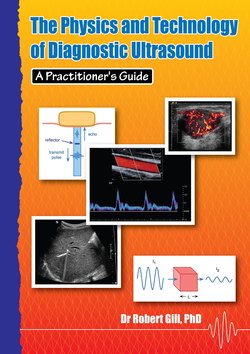The Physics and Technology of Diagnostic Ultrasound: A Practitioner's Guide

Реклама. ООО «ЛитРес», ИНН: 7719571260.
Оглавление
Robert Gill. The Physics and Technology of Diagnostic Ultrasound: A Practitioner's Guide
THE PHYSICS AND TECHNOLOGY OF DIAGNOSTIC ULTRASOUND: A PRACTITIONER'S GUIDE
Foreword
Chapter 1: Introduction. Introductory comments
Suggested activities
Physics and mathematics
Suggested activities
Mathematics - a brief review. Equations
Addition, subtraction, multiplication and division
Units
Scientific notation
Logarithms
Decibels
Reality checking answers
Exercises*
Chapter 2: Ultrasound interaction with tissue. Ultrasound waves and propagation
Frequency analysis
Suggested activities
Attenuation
Suggested activities
Reflection and scattering. Reflection
Scattering
Suggested activities
Refraction
Suggested activities
Chapter 3: Pulsed ultrasound and imaging. Pulsed ultrasound. Pulse duration and bandwidth
Pulse repetition frequency (PRF)
Suggested activities
Pulse echo principle
Pulse repetition frequency limitations
Frame rate limitations
Suggested activities
Principles of image formation
A, B and M mode
Suggested activities
Chapter 4: Transducers. Transducer principles
Suggested activities
Focussing
Suggested activities
Array transducers
Phased array transmit focussing
Phased array receive focussing
Linear array
Curved array
1½D and 2D arrays
Suggested activities
Beams, image quality and artifacts
Beamwidth
Slice thickness
Sidelobes
Grating lobes
Suggested activities
Chapter 5: Ultrasound instrumentation. Introductory comments
The machine's front end
Probe
Transmitter
Beamformer
Amplifier
Suggested activities
Signal processing
TGC
Digitisation
Filter
Amplitude detection
Dynamic range compression
Suggested activities
Image processing
Scan converter
Pre-processing
Image memory
Post-processing
Display
Image storage and recording
Suggested activities
Chapter 6: Image artifacts. Introductory comments
Suggested activities
Imaging assumptions
Attenuation artifacts
Shadowing
Enhancement
Edge shadowing
Suggested activities
Depth artifacts
Propagation speed artifact
Reverberation artifact
Ring-down artifact
Comet-tail artifact
Suggested activities
Beam dimension artifacts. Beamwidth artifact
Sidelobe artifact
Slice thickness artifact
Suggested activities
Beam path artifacts. Refraction artifact
Mirror image artifact
Suggested activities
Equipment and electrical artifacts
Summary
Chapter 7: Doppler ultrasound. The Doppler effect and its applications in ultrasound
The Doppler angle
Measurement accuracy
Suggested activities
Continuous wave (CW) Doppler
Pulsed Doppler
Spectral display
Suggested activities
Colour Doppler
Power mode colour Doppler
Doppler Tissue Imaging
Suggested activities
Chapter 8: Doppler artifacts. Spectral Doppler artifacts
Frequency aliasing
"High PRF" mode and range ambiguity
Intrinsic spectral broadening
Spectral mirror artifact
Mirror image artifact
Other spectral Doppler artifacts
Suggested activities
Colour Doppler artifacts
Colour aliasing
Colour dropout
Colour bleed
Angle effects
Mirror image
Twinkle artifact
Suggested activities
Chapter 9: Haemodynamic concepts. Cardiovascular system
Blood flow and blood pressure
Stenotic disease
Velocity waveform
Velocity profile
Venous disease
Suggested activities
Chapter 10: Equipment performance. Introductory comments
Spatial resolution
Axial resolution
Lateral resolution
Contrast resolution
Temporal resolution
Summary
Assessing equipment performance
Imaging performance
Doppler performance
Summary
Suggested activities
Chapter 11: Bioeffects and safety. Is ultrasound safe?
Mechanisms
Thermal bioeffects
Mechanical bioeffects
Suggested activities
Characterising ultrasound exposure
Government regulation
Policies and statements
Summary
Suggested Activities
Chapter 12: Additional modes and capabilities. Introductory comments
Compound imaging
Suggested activities
Harmonics
Tissue Harmonic Imaging (THI)
Contrast harmonics
Harmonic signal processing
Suggested activities
Ultrasound contrast agents
3D and 4D ultrasound
Extended field of view
Image optimisation
Image manipulation
Elastography
Suggested activities
Summary
Answers to mathematical exercises. Chapter 1 exercises
Page 11
Page 14
Page 16
Page 19
Page 21
Page 32
Page 37
Page 76
About the author
Acknowledgements
Отрывок из книги
This book has been written to help medical professionals (and others) to develop a sound understanding of the physical and technical principles of diagnostic ultrasound. It is intended for use either in self-guided study or in the context of a formal course or training program. It is assumed that the reader has access to ultrasound equipment and opportunities for scanning patients or volunteer subjects while they are studying from this book.
Inevitably the choice of topics and the depth to which they are covered has been selective. The coverage of the book has been designed to suit the typical university or professional course of study. Practitioners in highly specialised areas such as echocardiography may therefore need to supplement the material here by studying other resources.
.....
Reflection and scattering are the two mechanisms that produce echoes and so create the information shown in the ultrasound display.
As with light, the word "reflection" is used to describe the interaction of ultrasound with relatively large and smooth surfaces. (Think of light reflecting from glass.) "Scattering" refers to the interaction of ultrasound with small structures (red blood cells, capillaries, etc) within the tissues. (Think of light scattering from the tiny water droplets in a fog.)
.....